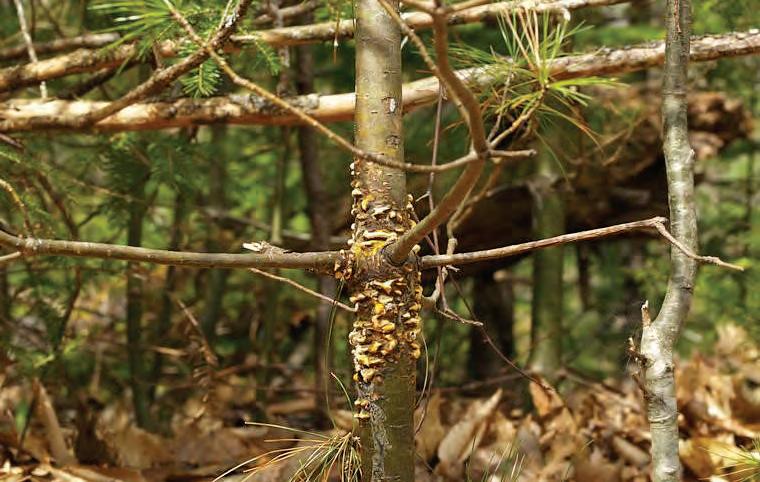
5 minute read
Why NCDA&CS Plant Industry Division Prohibits Currant and Gooseberry Plants in North Carolina
Fungal structure erupting from stem of young tree. Photo: Bruce Watt, University of Maine, Bugwood.org
The risk of an invasive fungal pathogen destroying North Carolina’s white pine trees (Pinus strobus) may be an increasing threat due to mail order shipments of gooseberries and currants (Ribes spp.). The North Carolina Department of Agriculture & Consumer Services (NCDA&CS) Plant Industry Division hopes to spread the word about why planting these popular edible fruits could have detrimental agricultural impacts on wild and cultivated white pines. Regulation through education is often the most successful way to garner public understanding and participation. Targeting wellmeaning homeowners with foundational knowledge regarding the potential risks associated with their thriving backyard garden may be the key to protecting white pines across our state.
Advertisement
In the early 1900s, a rust fungus known as Cronartium ribicola, the causal agent of white pine blister rust, destroyed the white pine forests of the northeastern United States. This rust fungus arrived on white pine seedlings imported from Germany, used to replant the lands stripped by timber companies. The widespread devastation caused by this fungus alerted U.S. legislators to the importance of custom and border protection and led to the passage of the Plant Quarantine Act in 1912. However, the law itself could not stop the pathogens that had already arrived in the U.S. and become widely dispersed. Early attempts to control white pine blister rust focused on destruction of infected white pine; unfortunately, this effort proved to be ineffective as researchers learned more about vectors and spread of the disease. Modern day efforts to control white pine blister rust focus on the known, required alternate hosts plants in the Ribes genus which contains about 150 known species.
The Ribes species grown by homeowners and niche farming operations for their edible fruit (currants and gooseberries) play a critical role in the spread of white pine blister rust. Like many other rust fungi, white pine blister rust requires an alternate host to complete its life cycle. The devastating disease starts when the orange rust spores (basidiospores) produced on the leaf of Ribes species infect the white pine — up to 1,000 feet away when spread by wind — through the needles. White pine blister rust infections occur when the weather is cool and moist. Spread of the disease occurs when the white pine blisters (which contain numerous spores called aeciospores) erupt through the bark of the white
By Hsien Tzer (HT) Tseng, Ph.D.
Plant Pathologist, North Carolina Department of Agriculture & Consumer Services, Plant Division
Join HT Tseng for a session on disease regulations and newly-reported diseases at Green & Growin’ 21 Virtual Education.

Leaves of Ribes sp. infected by white pine blister rust. Photo: M. Grabowski, UMN extension
Young white pine killed by white pine blister rust. Photo: M. Grabowski, UMN extension pine (Figure 1) and land on currants and gooseberries which then continue the cycle. Although multiple Ribes species can act as alternate hosts, white pine blister rust only affects white pine. Transmission of white pine blister rust from pine to pine is not possible and Ribes spp. must be present for the harmful disease to perpetuate.
Infection of white pine blister rust on Ribes itself causes minimal damage, such as foliage discoloration and minor defoliation. However, when the fungus is transmitted to white pine trees, the effects are more severe beginning with visible branch and stem cankers that eventually move to the main stem, leading to branch die-back, top-kill or whole tree mortality. The time between initial infection and visible canker symptoms is usually between 1-2 years.
Managing white pine blister rust, like all disease management, requires an integrated approach which combines cultural practices, pruning and planting resistant varieties. Because of the crucial role of Ribes spp. in facilitating the spread of white pine blister rust, North Caroline established a regulation to prohibit the sale, growing or planting of currants and

gooseberries in 1985 (02 NCAC 48A .0401). This regulation was enacted to protect white pine trees and young white pine plantations from the threat of the disease by requiring the following:
(a) All wild and cultivated currant and gooseberry plants in North Carolina are hereby declared to be dangerous plants and are consequently subject to destruction by the Commissioner of Agriculture or authorized agents wherever found.
(b) No person shall knowingly and willfully keep upon his premises any currant or gooseberry plant or permit such plants to mature seed or otherwise multiply upon his land.
Regulating the production of Ribes spp. in N.C. nurseries is relatively straightforward. However, with increased online mail order sources, monitoring and enforcement of this regulation is more challenging, causing an escalated threat to the white pines in our state. White pine is a significant landscape and agricultural species in N.C. According to USDA-Forest Serves, Forest Inventory and Analysis (2019), the lumber from the state’s white pines is worth more than 760 million dollars. Threats to white pine impact forestry, the Christmas tree and cut Christmas greenery industry as well as residential and commercial landscapes. The white pine blister rust regulation is reviewed periodically to ensure the risk of Ribes cultivation still poses a threat to N.C. agriculture.

If you know of Ribes plantings in the state, please alert the property owner of the regulations and risks or contact Dr. HT Tseng, Plant Pathologist with NCDA&CS Plant Industry Division at HT.Tseng@ncagr.gov.
Hair-like spore producing structures on the lower leaf surface of Ribes spp. Photo: M. Grabowski, UMN extension
HIGH QUALITY CONTAINER GROWN PLANTS
OLD COURTHOUSE NURSERY

If you need liners for fi eld planting or potting up, fi nished sized material for your holding yard, or any other high quality container grown material…

OLD COURTHOUSE NURSERY HAS YOU COVERED!

Visit our website for pictures, current availability and more info about our operation
Contact us Today (910) 293-9374 323 Old Courthouse Rd • Warsaw, NC 28398 oldcourthousenursery@embarqmail.com www.oldcourthousenurserync.com




